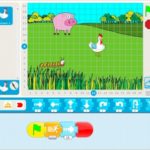How to teach programing language to a five-year-old kid
This new school year, Madrid and Navarre are already teaching programing to 8-year-old students. However, some experts believe that these classes should be given to children as young as five because they "learn to program, develop cognitive skills and improve their logical reasoning".

In 2014/2015, schools in Madrid and Navarre have started giving programing classes to 4th and 5th year secondary education students, respectively. This decision could “stimulate the alphanumeric skills and creativity of students”, as well as “their sequential thought”, according to Tufts University professor Marina Bers, who was responsible for the development of ScratchJr, an iPad app –soon available in Android and web versions– that enables students aged five to seven to learn programing by designing their own stories.
According to this professor, just as everybody knows how to write, any person should be able to program. In her opinion, a good command of programing language helps students to think, identify and solve problems, and also handle tasks that involve sequences and trial and error. The app involves connecting blocks, which act as code, and is based on Scratch, a programing language created in 2007 to teach children aged eight and over.
But, to what extent can a five-years-old kid learn to program? “When they go to a day-care center they learn to read, but this doesn't mean that they do so like an adult”, explains Mitchel Resnick, an MIT learning researcher and co-developer of ScratchJr. "The same happens" with ScratchJr, says Resnick, as it acts like a “precursor that teaches the hardest thing: to think how to program”, he says quoting Bers.

Children can develop their cognitive and social skills through programing.
Along the same lines, the professor of Education Sciences at the University of Seville and expert in technological learning, Julio Cabero, claims that children who "learn to program, perfect their cognitive abilities and improve their logical reasoning and their ability to solve complex problems”. Furthermore, albeit not a priority, this Spanish researcher believes that managing to get students to like these types of skills can favor future vocations. According to Bers, five is the ideal age to begin to program, an age at which “there are no stereotypes as to what and what cannot be done, and one is more open to new things".
Programming is not the priority for Espeso, but rather a “tool” the object of which is to develop computational thought that serves to solve problems. The IT expert also holds that it “greatly" increases creativity and considers that the ideal age to learn is eight, but admits to not having tried ScratchJr yet, which has been especially designed for the very young.
Program your own robot
Arduino is another programming - and robotics - tool for the very young. It consists of a free hardware platform that seeks to facilitate the use of electronics for the uninitiated. Indeed, there is even a Scratch version that has been developed to work with this platform. The researcher from the University of Malmö (Sweden) and co-founder of Arduino, David Cuartielles, compares the way of thinking encouraged by programming to that of a video game, “You want to get to the last screen but to do so you have to go through the other 20 beforehand”. That's why he believes that, if well taught, it can manage to “hook” the young children.
The Lego foundation, which has financed ScratchJr, is also committed to teaching programming language to children. One of its ideas, launched back in 998, involves the building and programming of a robot. In this way, young children can learn “science, technology, engineering and mathematics”, we are ensured on the company's web site. The fact is there is nothing new in these computer skills going beyond the mere computer screen. A 1986 study conducted on 72 children between six and eight years of age showed how these skills improve creativity.
Once the tools have been developed, there will have to be institutions that know how to incorporate them into their teaching plans, not to mention teachers prepared to implement them. Espeso feels it is essential to “train the teachers” so that computer language becomes an item of knowledge as basic as reading.